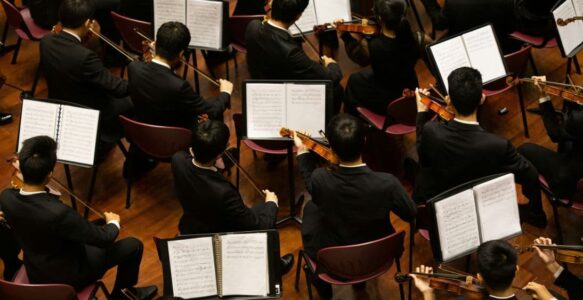For centuries, the symphony stood as one of the pinnacles of Western classical music. Composers like Beethoven, Mozart, Brahms, and Mahler poured their creative energies into crafting monumental multi-movement works for orchestras that pushed the boundaries of musical expression. Symphonies were eagerly anticipated cultural events, with new works premiering to packed concert halls. However, in recent decades, the symphony as a genre has experienced a marked decline in popularity and cultural relevance. This article will explore the various factors that have contributed to the waning appeal of symphonies in contemporary society.
Changing Musical Tastes and the Rise of Popular Music
One of the primary reasons for the symphony’s decline is the dramatic shift in musical tastes that occurred over the 20th century. The rise of jazz, rock, pop, hip-hop and other popular genres fundamentally altered the musical landscape. These new styles offered more immediate gratification, with catchy melodies, driving rhythms, and lyrics that spoke directly to listeners’ experiences.
In contrast, symphonies require sustained attention and musical literacy to fully appreciate. The complex harmonic structures, extended development of themes, and lack of vocals make symphonies less accessible to casual listeners. As popular music came to dominate radio, television, and other media, symphonies were increasingly seen as esoteric and elitist.
The changing economics of the music industry also played a role. Record labels and concert promoters found it far more profitable to invest in popular music acts that could sell millions of albums and pack stadiums. Symphony orchestras, with their large ensembles and expensive productions, became increasingly difficult to sustain financially.
Evolving Attention Spans and Media Consumption Habits
The digital age has profoundly impacted how people consume media and art. With smartphones, social media, and streaming services offering constant stimulation, attention spans have generally shortened. The idea of sitting through a 45-minute symphony movement uninterrupted has become foreign to many modern listeners.
Symphonies were composed to be experienced live in concert halls, allowing audiences to be fully immersed in the music. However, most people now consume music in bite-sized chunks while multitasking – listening on headphones during a commute or having music on in the background while working. The grand scale and narrative arc of a symphony is often lost in these fragmented listening experiences.
Additionally, the visual nature of modern media has conditioned audiences to expect constant visual stimulation along with audio. While watching a symphony orchestra perform can be visually engaging for some, many find the static nature of the performance less stimulating compared to the dynamic visuals of music videos, films, and video games.
Cultural Shifts and the Decline of Classical Music Education
Broader cultural shifts have also contributed to the symphony’s decline. Classical music education and appreciation were once considered essential components of a well-rounded education. However, budget cuts to arts programs in schools have resulted in fewer young people being exposed to classical music and developing the musical literacy needed to appreciate symphonies.
The cultural cachet associated with classical music has also diminished. In previous eras, attending symphony concerts was seen as a mark of sophistication and social status. Today, popular music and other forms of entertainment have largely supplanted classical music’s role as a signifier of cultural capital.
Furthermore, classical music’s association with European high culture has come under scrutiny in an era of increasing multiculturalism and globalization. Many view the symphony as a relic of a Eurocentric worldview that doesn’t reflect the diversity of modern society.
The Challenge of Contemporary Classical Music
While the great symphonies of the 18th and 19th centuries remain respected, if not widely popular, contemporary classical music has struggled to connect with broader audiences. Many 20th and 21st century composers have pursued increasingly abstract and experimental approaches, often prioritizing intellectual innovation over emotional resonance or accessibility.
This trend has created a disconnect between contemporary classical music and potential new audiences. While these avant-garde works may be appreciated by musical scholars and dedicated enthusiasts, they have limited appeal to casual listeners. The lack of compelling new symphonic works that capture the public imagination has contributed to the genre’s stagnation.
Economic Challenges Facing Symphony Orchestras
The financial realities of maintaining a full symphony orchestra have become increasingly daunting. With declining ticket sales and shrinking endowments, many orchestras have struggled to stay afloat. The high costs associated with paying a large ensemble of professional musicians, maintaining concert halls, and mounting productions make it difficult for orchestras to experiment or take risks with programming.
This economic pressure has led many orchestras to rely heavily on performing familiar works from the standard repertoire rather than commissioning new symphonies or showcasing contemporary composers. While this approach may appeal to core classical music fans, it does little to attract new audiences or keep the genre vital and evolving.
Competition from Other Forms of Entertainment
In today’s entertainment landscape, symphonies face stiff competition for audiences’ time and money. Live sporting events, blockbuster films, popular music concerts, and immersive video games all vie for consumers’ attention and disposable income. These forms of entertainment often offer more spectacle, social experiences, and immediate gratification compared to symphony concerts.
Additionally, the proliferation of high-quality recorded music and video streaming services has made it possible for people to experience a vast array of music, including symphonies, from the comfort of their homes. This convenience factor has reduced the perceived value and uniqueness of attending live symphony performances for many potential audience members.
Efforts to Revitalize the Symphony
Despite these challenges, there have been efforts to breathe new life into the symphony as a genre and institution. Some orchestras have experimented with more diverse and accessible programming, incorporating elements of popular music, film scores, and world music into their repertoire. Multimedia presentations that combine symphonic music with visual elements have also been used to attract younger audiences.
Educational outreach programs aim to expose more young people to classical music and foster a new generation of symphony enthusiasts. Some composers are also working to create more accessible contemporary symphonies that bridge the gap between classical traditions and modern sensibilities.
Conclusion: The Uncertain Future of the Symphony
The symphony’s decline in popularity reflects broader changes in society, culture, and technology. While it may never regain its former status as a dominant musical genre, the symphony remains an important part of our cultural heritage. The challenge for the classical music world is to find ways to make symphonies relevant and engaging for contemporary audiences while preserving the artistic integrity and ambition that defines the genre.
The future of the symphony likely lies in innovation and adaptation. This may involve reimagining the concert experience, embracing new technologies, fostering greater diversity in composers and performers, and finding fresh ways to connect symphonic music to the experiences and emotions of modern listeners.
Ultimately, while symphonies may no longer command the popular attention they once did, they continue to offer a unique and powerful form of musical expression. By addressing the challenges facing the genre and finding new ways to engage audiences, there is hope that symphonies can find a meaningful place in the diverse musical landscape of the 21st century and beyond.



